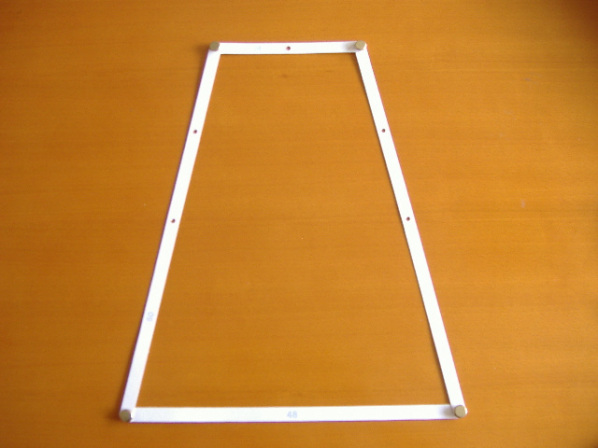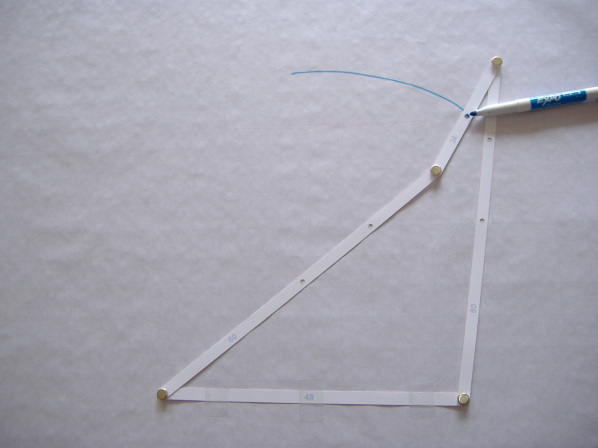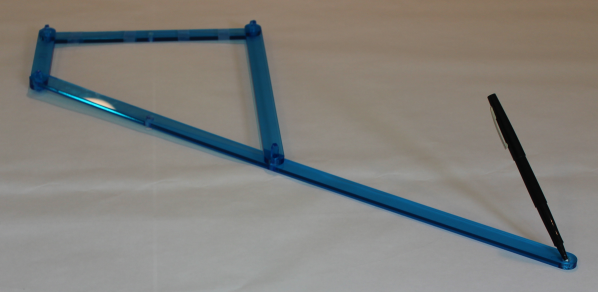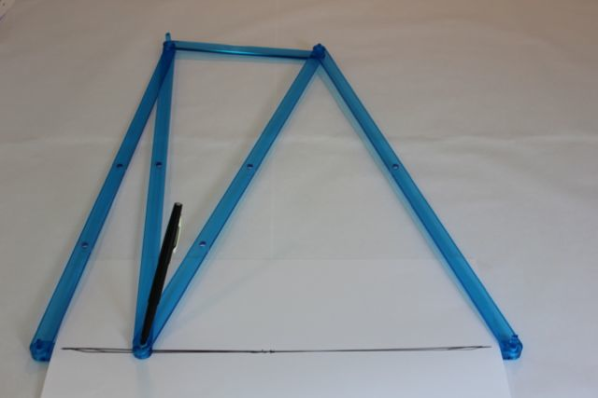Math Monday: Let’s Get This Straight
by Glen Whitney
If you recall, in the last installment before we took a breather, Math Mondays posed a question/challenge: Is there a four bar linkage that produces precisely straight motion? How about a linkage? Today’s column, rather than revealing the answer, shows the depth, subtlety, and persistence of this problem by giving three “near misses” that researchers trying to solve this problem created. The first of these was devised by the historically prominent mathematician, Chebyshev, showing that this was a problem of great mathematical respect and significance.
Chebychev Linkage
Ingredients: A 48-bar (A), two 60-bars (B and D), one 24-bar with a hole at 12 (C), and a pen.
Directions: Fix A horizontally. Link the left end of A to B to C0; link C24 to D and D back to the right end of A. Put a pen in C12.
To use: Move one 60 back and forth as far as it will go, keeping the pen in the hole drawing on the paper.
For a change of pace, here’s the linkage built by hand-cutting the kit parts out of paper instead of laser-cutting from acrylic, and using brass paper fasteners for the links: And here are two shots of it drawing; note how the 60-bars have to cross over each other to get the (seemingly very straight) section of the curve:
And here are two shots of it drawing; note how the 60-bars have to cross over each other to get the (seemingly very straight) section of the curve:
 When Chebyshev discovered that the curve above is not in fact perfectly straight in any portion, and was sufficiently stymied in his efforts to find a straight-line linkage, he conjectured that it was mathematically impossible to make any straight-line linkage. That did not prevent others from trying. Here are a couple of other attempts:
When Chebyshev discovered that the curve above is not in fact perfectly straight in any portion, and was sufficiently stymied in his efforts to find a straight-line linkage, he conjectured that it was mathematically impossible to make any straight-line linkage. That did not prevent others from trying. Here are a couple of other attempts:
Hoekens Linkage
Ingredients: A 24-bar (A), a 12-bar (B), a 60-bar with a hole at 30 (C), a 30-bar (D), and a pen.
Directions: Fix A horizontally. Link the left end of A to B to C0; link C30 to D and D back to the right end of A. Put a pen in C60.
To use: Rotate B one full turn, keeping the pen in the hole drawing on the paper.
Here’s the linkage, ready to draw: And here’s the completed curve:
And here’s the completed curve: Look familiar? Surprise, the Hoekens linkage and the Chebyshev linkage produce exactly the same curve. In fact, there is a whole theory of “cognate linkages” that produce the same output curve. This theory includes the Roberts-Chebychev Theorem, stating that “each coupler [output] curve can be generated by three different four-bar linkages.”
Look familiar? Surprise, the Hoekens linkage and the Chebyshev linkage produce exactly the same curve. In fact, there is a whole theory of “cognate linkages” that produce the same output curve. This theory includes the Roberts-Chebychev Theorem, stating that “each coupler [output] curve can be generated by three different four-bar linkages.”
Well, if Roberts was clever enough with linkages to have a theorem with Chebyshev on them, then he must also have his own linkage, right? Exactly:
Roberts Linkage
Ingredients: A 48-bar (A), four 60-bars (B, C, E, F), a 12-bar (D), two three-ply linkers, and a pen.
Directions: Fix A horizontally. Link the left end of A to B. Link the far end of B both to C and D. Link the other end of D to both E and F. Link the other end of F back to the right end of A. Finally, link the two loose ends — the far ends of C and E — together with a pen.
To use: Move the pen as far back and forth as it will go.
Here’s a picture of the Roberts linkage built and in action. Once again, looks straight, but it’s not. Note that the horizontal bar A is hidden underneath the paper that the linkage is drawing on. Next time: Resolution of the straight-line mystery.
Next time: Resolution of the straight-line mystery.
This article first appeared on Make: Online, December 10, 2012.